Let's go bird watching! Vol.2
Bird watching in spring
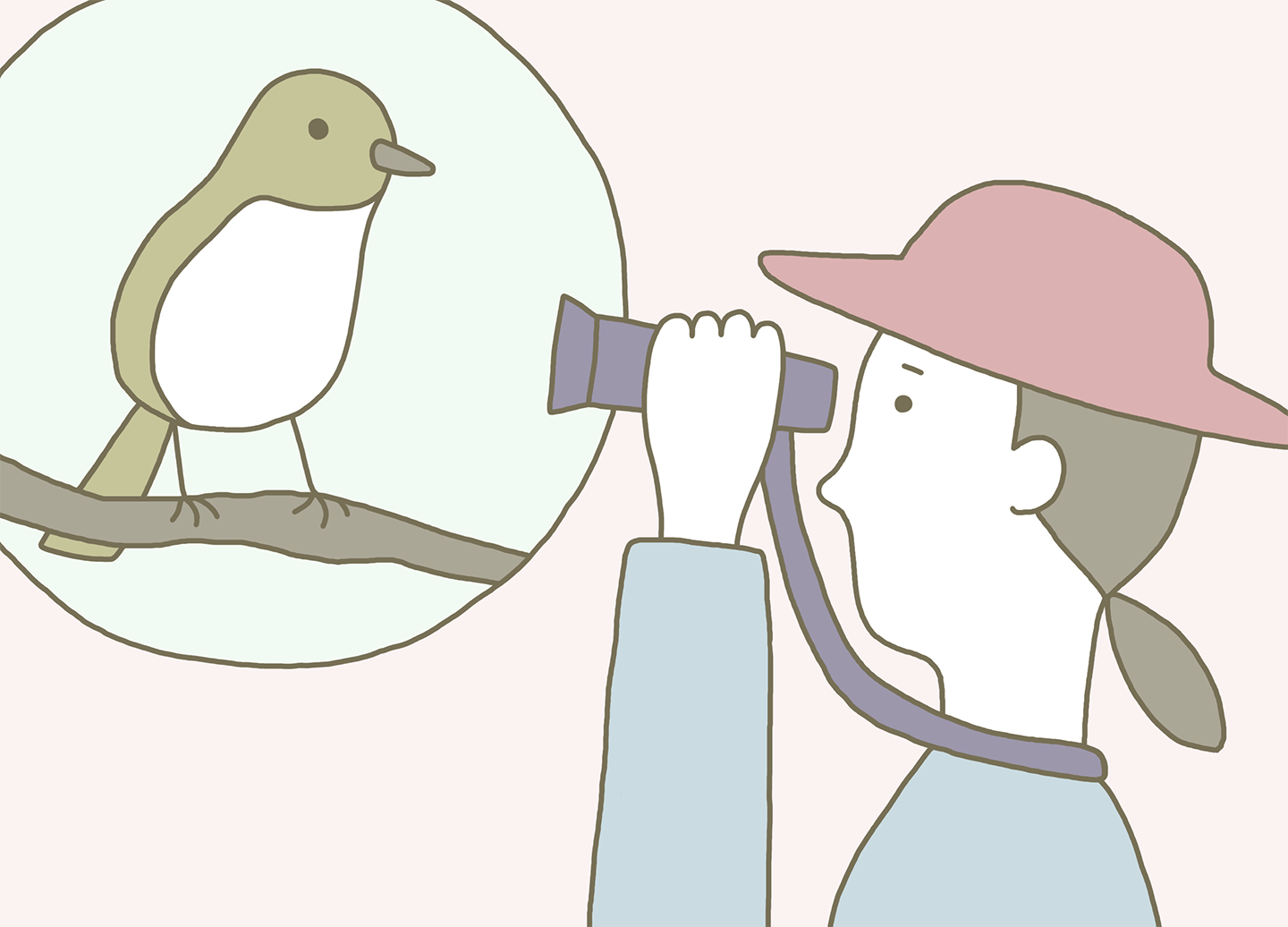

For birds, spring is the season for falling in love, mating, and raising their young. Many migratory birds (summer birds) come to Japan to breed. Spring is an enjoyable season for bird watching since the summer birds that come at this time have colorful plumage and there are many small birds that sing beautifully.

Many bird-watching events are held in Japan every year during the week starting from May 10, which is designated as “Bird Week.” It may be a good for beginners to search for and participate in events such as guided birding tours where they can learn more about birds and bird watching from experienced birders.
As explained in the section “Bird watching basics and equipment,” there are limits to searching for birds with just the naked eye. In spring, males sing spiritedly as they seek to attract females and guard their territory. Since you can use their constant singing as a hint in looking for birds, you could say that spring is the season for bird-watching beginners.


| Residential areas and nearby parks | Japanese Tit | Its song is a repetitious call of “chuppi“ or “chuchupi.” You can find it in trees in urban areas, parks, and residential areas. |
|---|---|---|
| Barn Swallow | Its song is a long series of continuous warbling sounds, something like “tsupi-tsuqui jubiktsui chutilililee juee.” It can be seen resting on power lines and in residential areas, and makes its nest in the spaces under the eaves of houses, garages, train stations, and highway service areas. | |
| Grasslands and cultivated fields | Eurasian Skylark | Sings its song of “pichupichhuli piichiriri-chukuchuku” in a quick voice while flying. It can be seen in such places as grasslands, rivers, and open fields. |
| Common Pheasant | Calls out “kekke-et” with a loud voice. It likes to hide in grassy areas and in the dikes of cultivated fields. | |
| Forests and groves | Narcissus Flycatcher | Its repetitive piccolo-like song is a compilation of such sounds as “hoihiiro”, “ooshitukutuku”, and “chicchililikokoinji.” It is often found in bright forest of flatland and mountain. It is easy to spot if you look for it on a branch midway up the tree. |
| Blue-and-white Flycatcher | Calls out “pi-li-li-jit-jit” with a clear voice that carries well. It characteristically sings from the top of a tree. It is often found in forest groves beside mountain streams. |
Its song is a repetitious call of “chuppi“ or “chuchupi.” You can find it in trees in urban areas, parks, and residential areas.
Its song is a long series of continuous warbling sounds, something like “tsupi-tsuqui jubiktsui chutilililee juee.” It can be seen resting on power lines and in residential areas, and makes its nest in the spaces under the eaves of houses, garages, train stations, and highway service areas.
Sings its song of “pichupichhuli piichiriri-chukuchuku” in a quick voice while flying. It can be seen in such places as grasslands, rivers, and open fields.
Calls out “kekke-et” with a loud voice. It likes to hide in grassy areas and in the dikes of cultivated fields.
Its repetitive piccolo-like song is a compilation of such sounds as “hoihiiro”, “ooshitukutuku”, and “chicchililikokoinji.” It is often found in bright forest of flatland and mountain. It is easy to spot if you look for it on a branch midway up the tree.
Calls out “pi-li-li-jit-jit” with a clear voice that carries well. It characteristically sings from the top of a tree. It is often found in forest groves beside mountain streams.
When birds become a couple, they build a nest, mate, lay eggs, incubate the eggs, and feed the hatchlings, and as early as May the chicks may already be leaving the nest. You should be able to see parent birds as they frequently leave the nest to get food for their hatchlings. And, even after they have left the nest chicks do not become fully independent right away; they follow their parents around, receiving food from them. During that time, they learn essential survival skills such as how to fly and how to find food.
Bird watcher's report:
Text and photos by a member of the Canon Bird Branch Project

On a clear day in the middle of May, members of the Canon Bird Branch Project gathered at a park in Tokyo. The instructor that day was Mr. Hideaki Anzai, Consultant at the Wild Bird Society of Japan. With over forty years of experience, Mr. Anzai is well known in the bird world. When it comes to bird watching, the goal tends to become focused on seeing many types of birds. However, even if you specifically go out to a well-known birding spot, things may not turn out as you expect since you are interacting with nature and living things. Since there were some first-time bird watchers participating this time, the program for the day centered on enjoying a relaxing time without going far.
When I heard that our target was going to be common birds that you see everywhere, such as Eurasian Tree Sparrows, crows (Large-billed Crows), White-cheeked Starlings, and Brown-eared Bulbuls, truthfully speaking, I was somewhat disappointed. But then Mr. Anzai said with a big smile, “We can see things that we can only see at this time of year!”
At the entrance to the park, we had a lesson in using binoculars, and then when we were all ready we set out for bird watching.
1
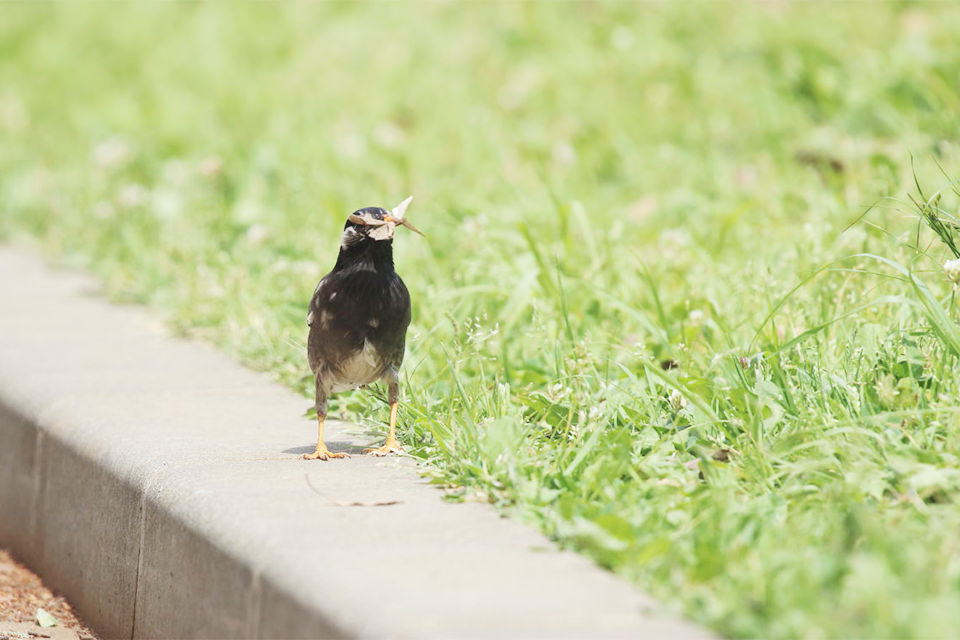
White-cheeked Starlings swooped down one after another onto the lawn stretching along the road, pecking the ground and picking up insects. There were some who had 2 or 3 insects collected in their beak. I thought that was being greedy, but Mr. Anzai said, “That's not it.” The reason for picking up several insects at once and not just one is because the chicks are growing quickly. Apparently, it was not for them but for their cute little chicks. My apologies.
And, when we saw two birds together, we learned that the darker colored one was the male, and the lighter colored one was the female. But, it seems that you can tell the difference in coloring only when a male and female that are mating are standing side by side. The color of the mating male is darker than usual.
As we were able to see many couples that day, we could tell the males from the females, and we could guess how much the chicks in the nest were growing by the amount of food the parents were carrying.

2
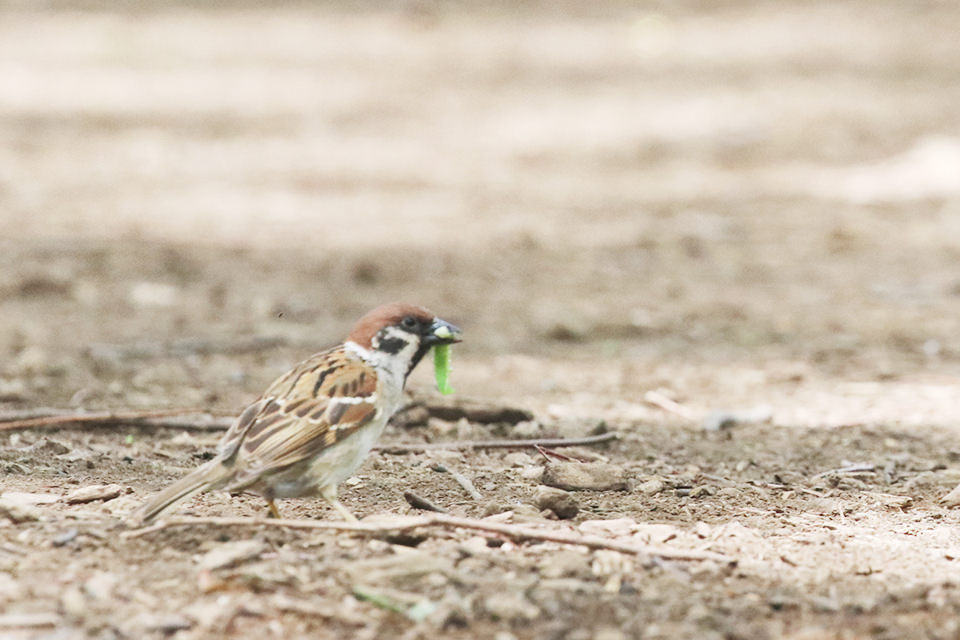
Next, we saw a similar scene: a Eurasian Tree Sparrow carrying an insect in its beak. Mr. Anzai noted warmly, “That sparrow has chicks in the nest I'm sure.”
He explained: “Seed-eating sparrows do not really eat insects. For chicks, however, the insects are a good source of nutrition and they are easy to digest, so the parents have to do their best to get some for them. Catching insects is evidence that they have newly hatched chicks.”
He also taught us some things about their beaks. The beaks of seed-eating birds such as sparrows are shaped like pliers so they can break hard seeds. It seems that the beaks of birds have evolved over time, taking several different shapes according to the food they eat and in order to make food easier to find and eat. It is very interesting.
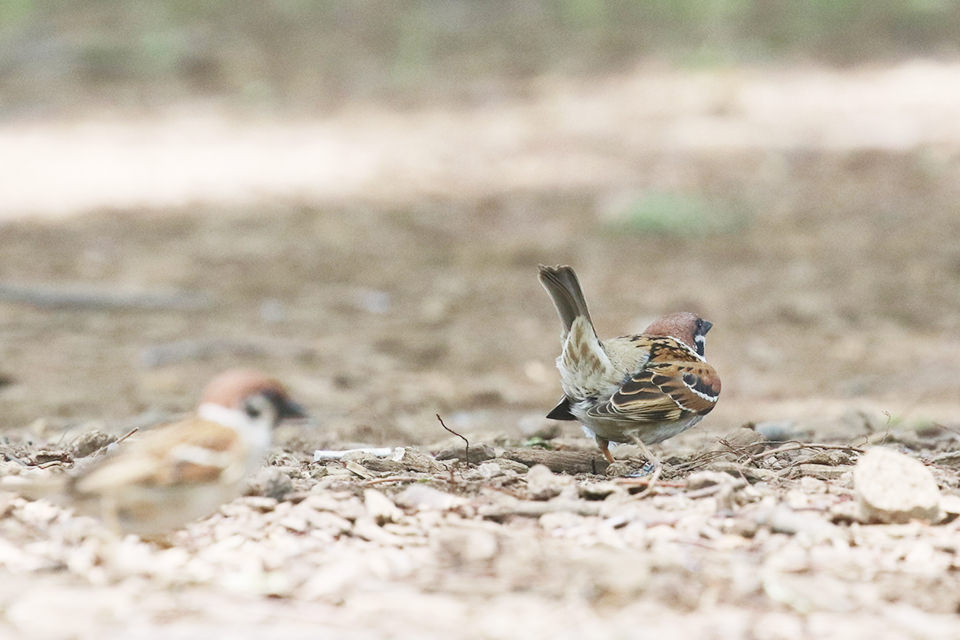

After walking a little while, we saw a sparrow eagerly flicking its tail up and down at another sparrow that was walking on the grass. It was a male posing to attract a female. Seeing this, Mr. Anzai commented, “If a female is carrying an insect that means she is already another bird's mate and a mother. That male doesn't have a chance.”
Seeing the male follow after the female, flicking its tail up and down even though it had no chance, Mr. Anzai wrote him off completely, saying, “It's quite pathetic how desperate the male gets when he doesn't have a mate yet halfway through the breeding season.”


3
There were many sparrows in the park. When you look closer you notice that there is not just one bird but rather several together in a group. This is a sparrow family, which can only be seen at this time of year. Small birds like sparrows leave the nest as soon as they can fly, moving around together with their parents and getting food from them for some time as they receive training so they can live on their own. This training period is about ten days, occurring over a limited period between spring and early summer. Observing this heartwarming scene of parents with their young was one of the goals for the day.
We learned from Mr. Anzai that the way to identify the chicks is by looking at their cheeks. The black part of the sparrow's cheek is light while they are young, but by the summer of their first year, the black part becomes as dark as adults. There is not much difference in size between juvenile and adult sparrows. Thinking about it from a human perspective, the body of a child is smaller than that of an adult, but for birds, this is often not the case so be careful that you are not deceived by the appearance.
Pay attention to the voice as well. When you hear a scratchy call of “shilyu shuily” instead of “chun chun,” that is the voice of a chick. This too will change as the bird grows, soon becoming “chun chun.”

4
After walking in the park for about an hour and a half my legs gradually got tired. We found a pavilion so I thought I would take a rest, and as I started walking in that direction I saw several busy-looking sparrows disappearing one after another into crevices in the ridges under the roof. This pavilion is apparently something of a sparrow nest apartment complex.
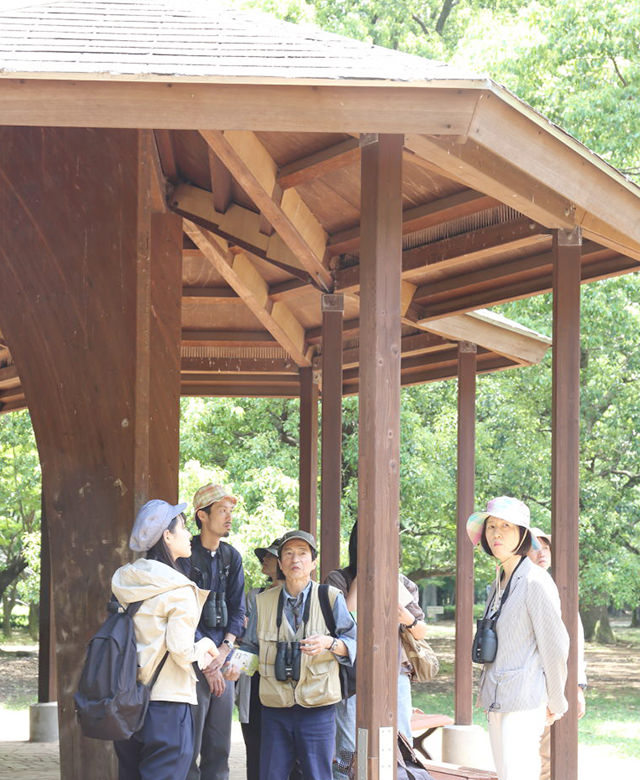
Mr.Anzai expalined how to tell what stage the nest building is by the things, which the bird is carrying in its beak.
To be sure, the sparrows that came back from outside were carrying various things in their beaks, including dry grasses that looked like straw, feathers, and insects. In the first stage of nest building, they use fairly sturdy materials to create a framework, and then progressively layer finer, softer materials to complete the nest. In the final stage, they bring in feathers from other birds and hair from cats or other animals to create a soft cushion to gently hold the eggs.
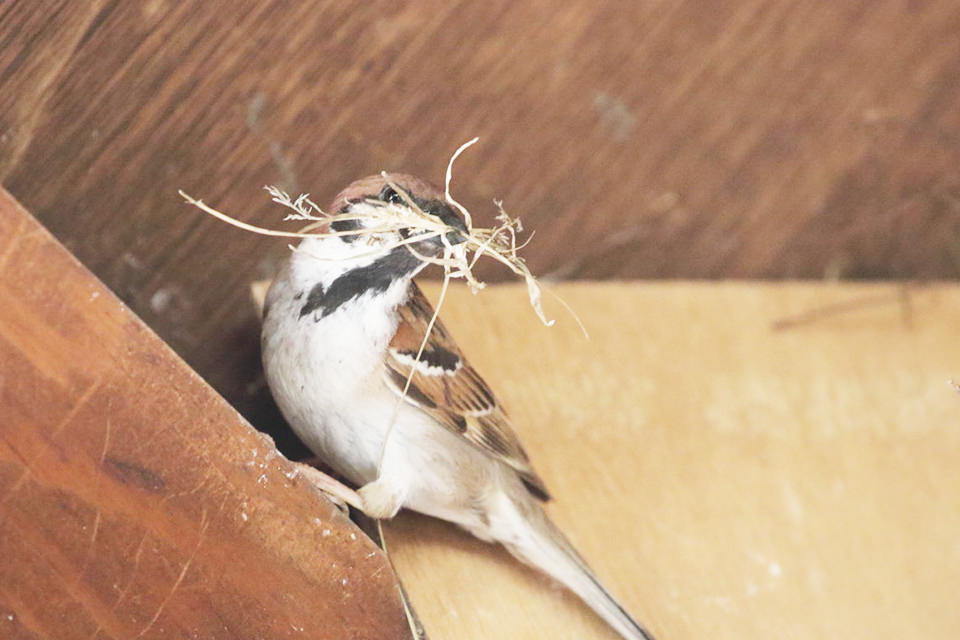
We did our best to identify what the returning sparrows were carrying in their beaks. Occasionally a parent would return with an insect and we could hear the chicks eagerly calling “shili, shili,” as a child might say “gimme, gimme” to hurry their parent. There were many families living in the pavilion, and sometimes a fight would break out between two males. According to Mr. Anzai, in the olden days sparrows would build a nest in “crevices” in the tiles or roof of a traditional Japanese house, but in recent years modern buildings have become the norm so fewer and fewer houses have such spaces or crevices, leaving the sparrows to contend with a housing shortage. Some small birds such as sparrows breed two or three times during the spring into early summer. Of the three or four eggs that are laid after each mating, usually two chicks successfully reach maturity and leave the nest. Unlike humans, the mortality rate among small birds is high, so they have to produce many offspring.
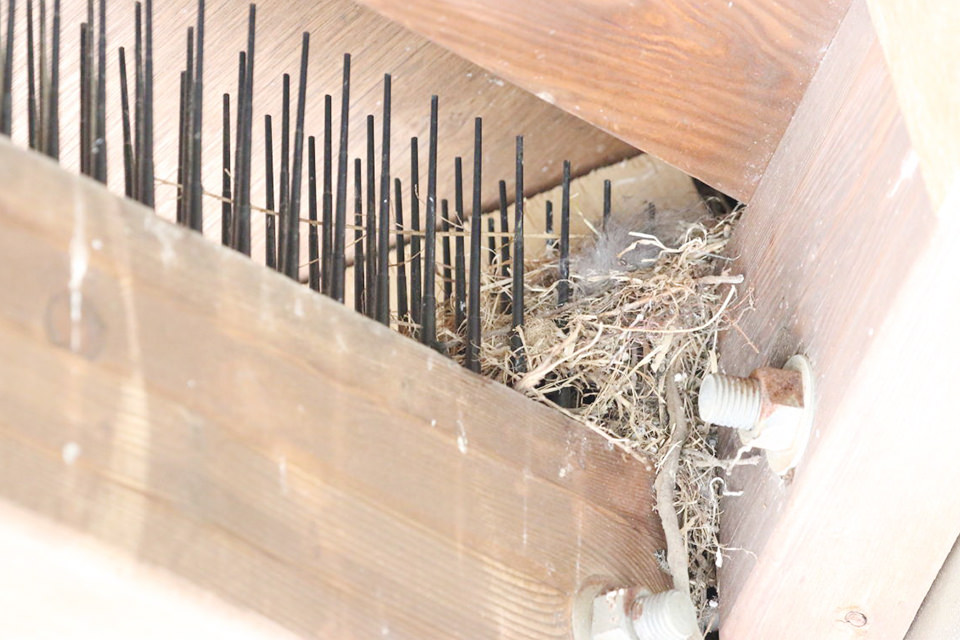
5
Since there was so much going on at the sparrow nest apartment complex in the pavilion, we could observe the birds without getting bored. Then it happened. Pointing at two sparrows on a corner post of the pavilion, Mr. Anzai let us know that the birds were mating.
Mating takes but a moment; the male climbs onto the female several times and then flies away right afterward. But, we were all thrilled to witness such a moment, which you rarely get to see. According to Mr. Anzai, the birds use a gentle call of “hiyohiyohiyo” to invite their partner to mate. This time I could not hear the sound because of the noise but I would very much like to hear it.
As we were heading back, Mr. Anzai had his attention drawn by two crows perched on a branch. At this time of year, couples are busy raising their young, but juvenile crows, which take two years to reach breeding maturity, form a flock and live together.
It is difficult to judge whether birds are coupled or not, but it seems that the deciding factor is whether they groom each other or not. With these two birds, there was a repetitive pattern of one trying to get close and the other moving away, so according to Mr. Anzai it was likely a young male and female that had not yet become a couple. The look of the aloof female and the hopeful male... This innocent scene reminded us of the bloom of youth.
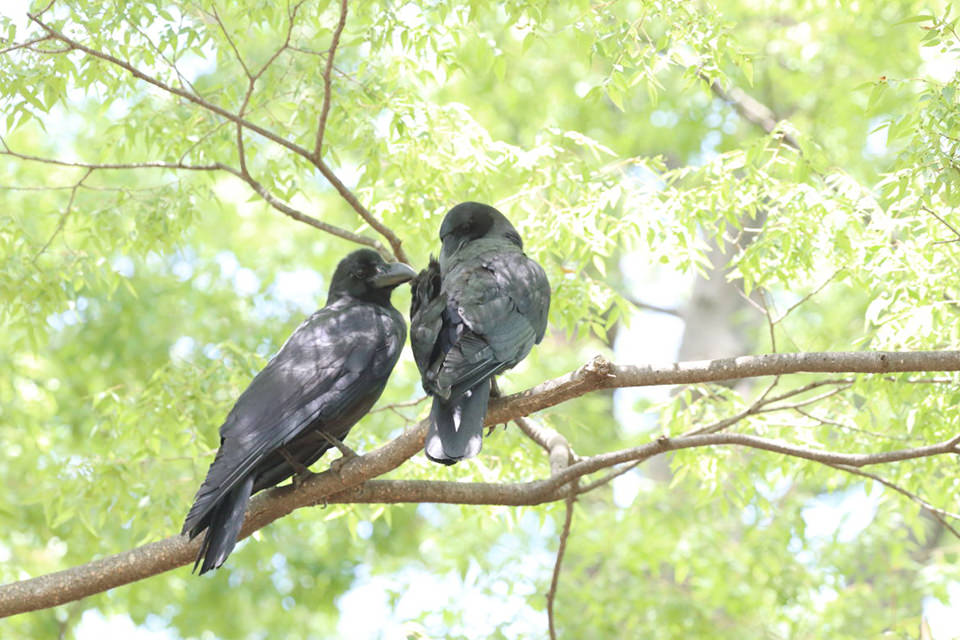
Although this time it was a short excursion of about 90 minutes, it was very satisfying bird watching. Until then I had thought that bird watching was about “seeing” many kinds of birds. Even when I saw a sparrow flying, I just thought: “There's a sparrow flying.” It did not occur to me to notice what it was carrying in its beak.
Listening to Mr. Anzai's comments this time, I understood the importance of “carefully observing” where the bird is and what it is doing.
I was surprised that I could figure out what a bird was doing, and whether it was mating or had chicks by what it was carrying in its beak. There are many interesting things and things I do not know about even common birds such as sparrows and crows. So when you are out walking in your neighborhood park, please take time to observe more closely what the birds you find are doing.
White-cheeked Starling, Eurasian Tree Sparrow, Large-billed Crow, Japanese White-eye, Oriental Turtle Dove, White Wagtail, Japanese Tit, Japanese Pygmy Woodpecker, Varied tit, Eastern Spot-billed Duck